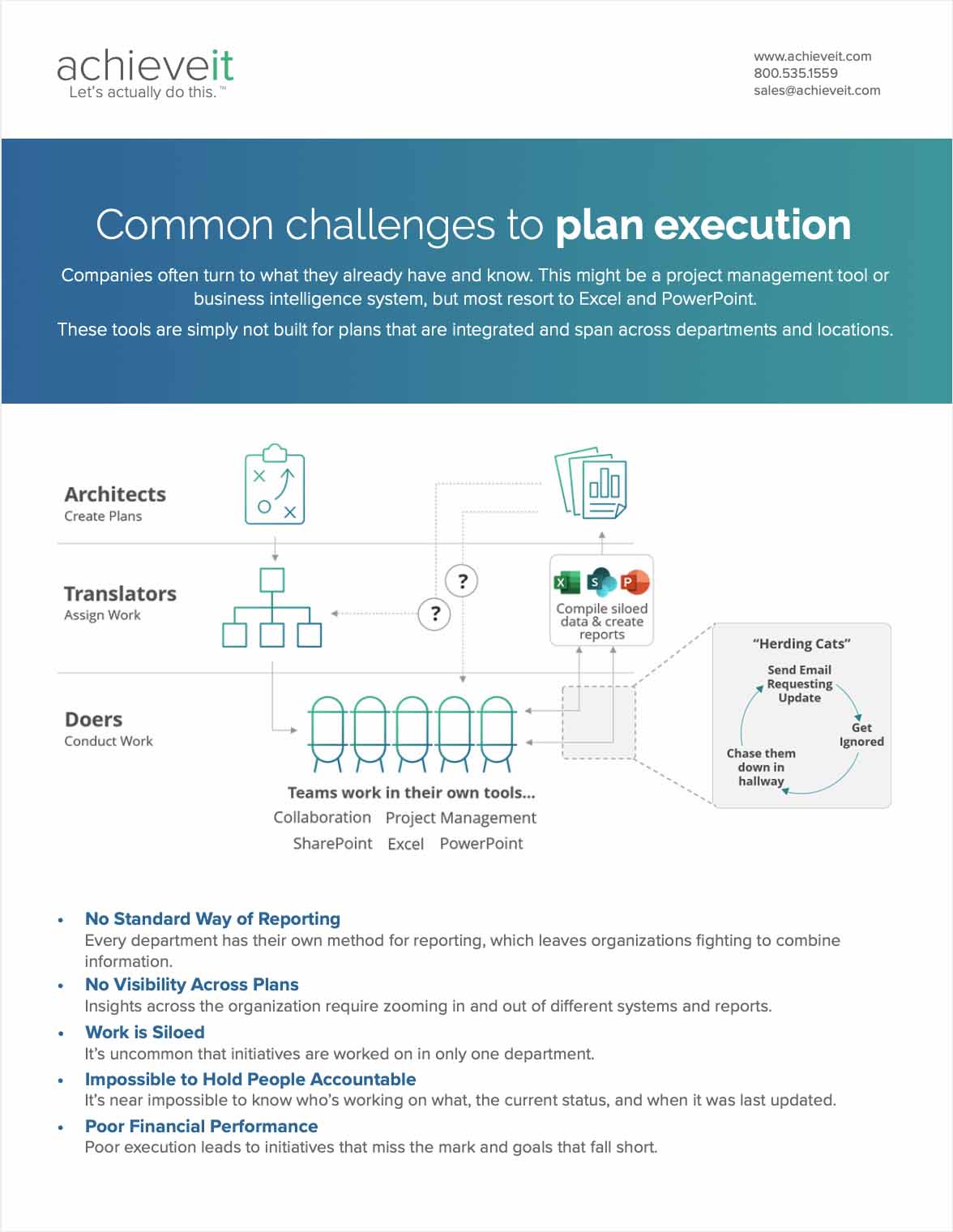For many organizations, a strategic plan is a compass that guides all company activity. It determines future success.
But the same organizations struggle with the strategy execution of these plans. There are plenty of studies that confirm this fact. An HBR study of 400 CEOs revealed that strategy execution was the number one challenge facing organizations.
This information is really important. It’s especially surprising considering other challenges like political instability, competition, and more.
While strategy execution is difficult, the cause is a bit harder to pinpoint. Sometimes, execution failure is due to individual employee performance. Other times, unforeseen market shifts, like volatile oil prices, are to blame for missing plan targets.
From a leadership perspective, these causes are tough to tackle. In most cases, the team does have an effective strategy. It just fails somewhere in the strategy execution phase.
So, we decided to focus on common issues we see within organizations. These obstacles represent clear opportunities for organizational improvement. By tackling these obstacles to plan execution, you clear the way for better organizational performance and strategy execution.
In This Article
- 6 Common Obstacles to Strategic Plan Execution
- Navigate Common Challenges When Executing a Plan With AchieveIt
6 Common Obstacles to Strategic Plan Execution
The first step to overcoming your company’s plan execution challenges is recognizing and understanding the main barriers to plan execution. After all, you can’t achieve excellent results without first knowing what stands in your way.
1. Lack of Clear Objectives
Have you ever received a mandate like ‘increase sales’ or ‘decrease costs’?
These business objectives may fulfill a larger strategic objective for the company but are hardly actionable for those responsible for execution. The problem lies in specificity – The objectives themselves are not flawed. In fact, they probably collectively build an effective strategy.
It’s the “how” that’s missing. The means of strategy execution are notably absent.
Without specific directives around the ‘how to’ and ‘how much’, stakeholders are often left playing the guessing game. Leaders need more detail about where to spend time and resources to move the needle.
To overcome the obstacle, increase clarity and specificity to objectives. Objectives should all be aligned to quantifiable metrics. An objective or goal should either increase, decrease, or be maintained.
When building out objectives, ensure that you’re clear on the current value, the future goal, and the time period given. This is important beyond leaders and managers to other team members to provide structure and guide success.
2. Lack of Buy-In from Stakeholders on Strategy Execution

Achieving buy-in from stakeholders for your plan starts with a clear understanding of all the components.
But further, it is important that stakeholders understand the “why” behind the plan. The “why” is how the plan cascades to strategies that relate to their roles and responsibilities. In many scenarios, managers and employees will ask themselves the WIIFM question – “What’s in it for me?”
With ownership of the spirit behind the plan, leaders and team members will see key objectives and tactics less as mandates. Instead, they are more of imperatives for both their own success and the success of the company at large.
A true sense of ownership is achieved when all relevant stakeholders feel they have a hand in the construction and communication of the plan.
As you build your plan and key strategies, leverage collaboration from initial ideas, to plan construction, and into the execute phase. By including key leaders and managers in the planning and implementation process, you increase the overall buy-in to the plan.
With management and employees both feeling heard, the organization will feel a sense of ownership for its execution.
FREE RESOURCE
Common Challenges to Plan Execution Guide
Download this guide to understand how organizations who establish uniformity, create visibility, and promote accountability excel at execution.

3. Lack of Visibility into Plan Execution Progress
The importance of visibility into strategy execution begins with instilling a sense of confidence amongst all stakeholders.
Not just confidence in the critical strategies and challenges, but that the right focus and resources are on the strategic plan. That progress is being made by the right people at the right time for the business’s success.
But visibility also affords a more significant advantage. With a culture of transparency, strategy execution impediments can be identified and solved collectively in a more expedient manner.
Visibility is not meant to be a tool for punitive action. It’s meant to highlight the strategic plan and encourage a proactive analysis and action from leaders. When everyone is privy to work being completed, everyone can assist in ensuring success.
As you work to increase visibility, don’t just focus on leadership. Extend insights and communication on progress across the company to various levels of management and all employees.
Create cascading levels of reports and insights that highlight strategic plan success that’s relevant for the group of employees viewing the information. Start with a high-level company overview and cascade the reporting visibility accordingly. Increase the focus on key objectives relevant to managers and business units as you cascade.
The goal with visibility is to increase the understanding of strategy execution progress throughout the business. Not to just focus on the leaders at the top of the organization. By spending time to highlight key strategies during the implementation of your strategy, you help increase buy-in across the organization.
Regardless of your approach to transparency, any level of visibility helps tremendously in keeping everyone on the same page.
There are many obstacles that inhibit strategic plan success. These three are very commonly seen across organizations of all industries and sizes.
4. Lack of Alignment
Carrying out your company’s goals is only possible if your team’s priorities align with these objectives. Many businesses prioritize nonstrategic work over strategic objectives because these routine tasks tend to be easier to execute. However, if this work does not align with your strategic business goals, they will be much harder to achieve.
The key to ensuring proper strategic alignment is clearly establishing your organization’s strategic objectives and assigning these tasks to team members across your business’s hierarchical structure. This tactic promotes complete strategy support, prioritization and facilitation.
5. No KPIs or Poor KPI Measurement/Tracking
Key performance indicators (KPIs) are metrics used to quantitatively measure an organization’s performance across its core objectives. Developing your business strategy without any KPIs means working toward your company’s goals without a means of measuring its success. KPIs also provide valuable data that you can use to further improve your strategy.
It’s not enough to simply incorporate KPIs in your organization’s strategy — you must also ensure that you’re measuring them properly to avoid data errors and lack of strategy follow-through. Make sure you assess the strength of your KPIs and measure all relevant data and outcomes to obtain the highest-quality information.
You should also verify and validate your data to confirm that it’s accurate and free of errors. Then, present your performance data using easily readable visuals and contextual information to get the most out of your KPIs.
6. Lack of Communication About Your Plan

Communication breakdowns can be detrimental to strategy execution. Clearly communicating your plans to your employees is necessary to ensure effective strategy execution. As a result, it’s vital that each member of your organization is fully aware of your strategic plan and how their individual responsibilities contribute to achieving the overarching goal.
You can promote more effective strategy execution by providing your staff with the necessary information to understand your business plan. Remember to emphasize quality over quantity — in other words, a few meetings and emails that clearly explain the plan will be more effective than multiple gatherings with confusing jargon.
Navigate Common Challenges When Executing a Plan With AchieveIt
You can combat common plan execution challenges with technologies from AchieveIt. Our strategic planning and execution software is designed to improve visibility, establish uniformity and increase accountability to help companies execute their key initiatives.
Book your AchieveIt demo today!
Ready to improve your plan execution?
Organizations of all types leverage AchieveIt to manage, execute, and connect their most important initiatives. Replace manual processes & siloed systems with interconnected plans in a single, automated platform.



